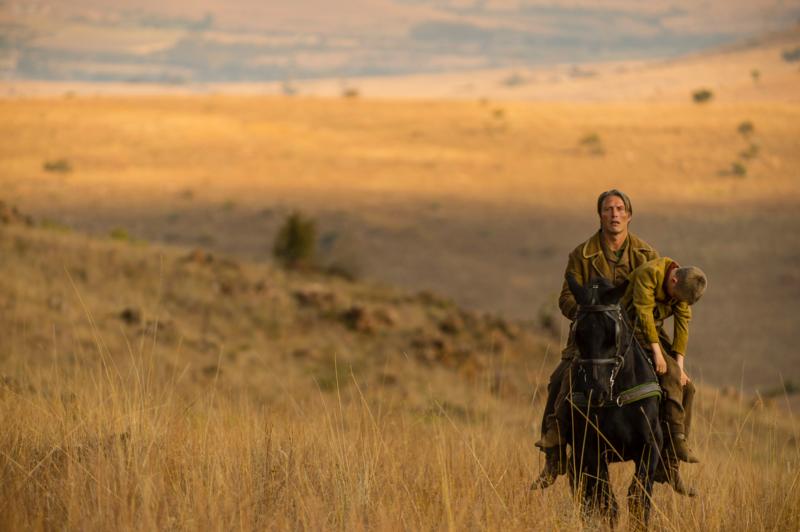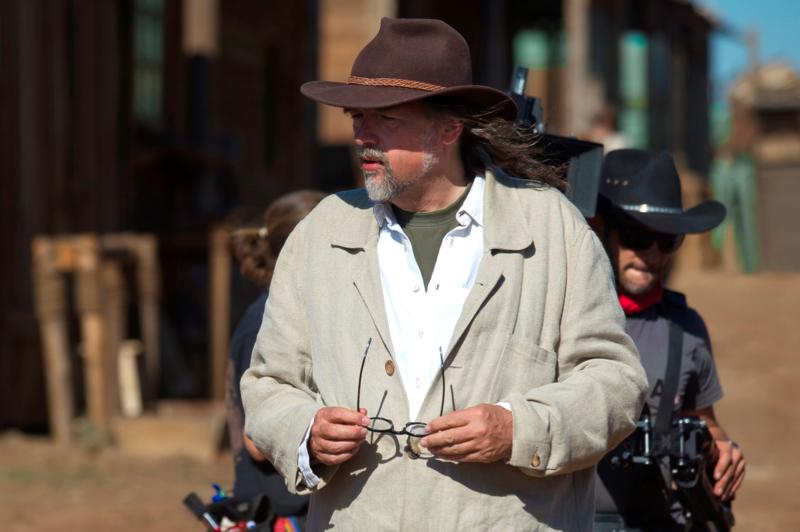By Wendy Mitchell
Kristian Levring, a 57-year-old film industry veteran, lights up with child-like glee when he talks about his love of Westerns. As a boy growing up in Denmark, he watched classic Westerns on TV on Saturday afternoons. And now he's made his own, "The Salvation".
"It's a childhood dream come true. It's like playing again, being a boy." – Kristian Levring
"It's a childhood dream come true," he says. "It's like playing again, being a boy."
For anyone expecting a Dogme Western, look elsewhere. "The Salvation" is pure genre, reveling in films of bygone eras while having a colourful modern punch as well. " To do an arthouse Western wouldn't make any sense. I wanted so much to do a genre film, a classic Western," Levring explains.
Levring grew up as "a huge fan of Ford, Leone and Kurosawa, too – "Seven Samurai" is a Western in my book," he says. "It's so exciting to be able to play in their playground."
In addition to all those Saturdays in front of the TV, another inspiration was meeting the writer of "High Noon", Carl Foreman, while Levring was studying editing at the National Film School of Denmark and Foreman was a visiting teacher. "'High Noon' was a film I loved, and he felt it – that I loved it. He invited me to dinner, we kept in touch when he was in London. When I got frustrated at something at film school, he said, 'Don't worry about it, John Ford never went to film school.'"
As much as Levring loves the genre, he wasn't always sure he would make a Western himself. It was a conversation about three years ago with Zentropa's Peter Aalbæk Jensen that pushed the idea forward. "Peter Aalbæk and I were sitting in Soho in London having lunch and some nice Barolo. We were talking about where we came from. I was sure he thought my first loves were Antonioni or Godard, but for me that was much later. Over another bottle of Barolo, we talked about our love of Westerns," Levring remembers. "He said, 'You should make a Western, Kristian.' I said, 'It's impossible to finance a Dane making a Western.' And he said, 'No, I think I can!'"
A Fun Writing Process
Levring "had an old idea in a drawer" for the bare bones of the story so he called screenwriting collaborator Anders Thomas Jensen, who like producer Sisse Graum Jørgensen had worked with Levring on 2008's "Fear Me Not". Jensen, whose credits include Oscar winner "In A Better World", was very keen on the idea of trying a Western.
"Writing the script was as fun as shooting it," Levring recalls. "It's so different when you work with characters who are more spare. There's less dialogue in the film compared to most Scandinavian films."
The pair also drew inspiration indirectly from the Nordic sagas. "The sagas are spare and primitive, but with big themes like revenge and love," he says. "When we wrote it we were talking about using that kind of background in telling the story."
What they came up with was the tale of a Danish settler in 1870s America, who sets out to avenge his family's murder and confront the gang leader in a corrupt community.
"The Salvation" feels very much a film that celebrates past Westerns on screen, rather than just presenting the reality of the Wild West.
"I made a Western that's a myth about Westerns," says Levring, although he adds that he did a lot of research for authenticity.
Another question of the script was how much violence to include – and there is a final shootout that has the modern feel of Quentin Tarantino or Robert Rodriguez. "There is a lot of violence in the genre, but I didn't want to make it a splatter film," Levring says. "It wasn't appropriate for this film, it needed to be reasonably elegant with the violence. I thought it would be emotionally stronger without too much blood."
Levring's background as an award-winning commercials director for two decades – for huge clients such as Mercedes, BMW and Carlsberg – came in handy with some of the big choreographed scenes such as the shootout. "I never had the opportunity to play with those 'tools' making a movie before," he says.
Assembling the Cast
Levring's first choice to play the Danish settler, Jon, was the much-in-demand Mads Mikkelsen. "He's made for the Western. He's a very physical man, and there is the sparseness of his craft." Fellow Scandinavian Mikael Persbrandt plays his brother.
The colourful gang leader Delarue is played by Jeffrey Dean Morgan, an American actor who Levring says is "not your obvious baddie."
Eva Green has a challenging role playing a scar-faced woman rendered mute after her tongue has been cut out. "She had that strength," Levring says. "It was hard to play someone who can't speak at all."
And, in a surprising turn, footballer-turned-actor Eric Cantona plays one of Delarue's sidekicks. "I'm a Man U [Manchester United] fan, and I never imagined he'd say yes," Levring says with a grin.
The accents very purposefully don't match. "That's how it was. The West was a melting pot of different immigrants," he says. "The majority of people who survived in the Wild West were European immigrants. Mads' character is Danish but he's an all-American character. People like that will never go back. They may have an accent but they are all American. It's interesting that these Danes were part of American history."
The other stars were equine. "I've filmed a lot with animals, but the horses are quite tough to work with. They don't go where you tell them to," he says with a laugh.
Shooting in South Africa
"It sounds very banal, but this film was made with a lot of enjoyment," Levring says, sounding almost guilty for having such fun on a film production.
Yet of course there were challenges too. Working on an £8 million budget for a film of this scale was tight. The team immediately ruled out shooting in America because of the expense involved. Instead they shot the entire film for eight weeks on location in South Africa, on a huge farm about 70 kilometers north of Johannesburg where they could build all their own sets.
They built about 18 houses and buildings to comprise the towns of the film – augmented with another 40 or 50 houses added digitally in post-production. All houses were built for the purpose of shooting both interiors and exteriors, not just frontages. Being able to inhabit a "real" space "brings a lot to the actors," the director explains.
Working outdoors rather than in a studio space also brought a lot to the production's mentality. "I love to work outdoors. You can be waiting for the sun to cast shadows on a landscape. It's about getting the most out of things. It's an old-fashioned way of filmmaking."
Levring had shot in Africa before, on commercials shoots in South Africa and also in neighbouring Namibia for his 2000 Dogme film "The King Is Alive".
One trick he learned from commercials was to bring in only a few heads of department and instead recruit local crew members as much as possible. "It's great to work with local people, and there are great crews in South Africa," he explains. "You learn something about the country and it's not the usual arrogance of bringing in all your own people."
The Right Look
Working with his usual DOP Jens Schlosser Levring enjoys the process of sitting down to talk about approaching each of his films with the right technical expertise. "We talk about techniques and equipment and what cameras are available. I'm into technology, to me filmmaking is a technical discipline." For "The Salvation", they shot on the ARRI Alexa.
During post-production, some 900 shots were manipulated, "by far" the most he's done on any film. "We had to create this world of America that looks real," Levring adds. They shot footage in real places like Utah and Montana to add into the landscapes. Also, South African trees were removed in post.
Before the shoot, because of the scale of the project and its budget, his team created computer-generated storyboards for the entire film. "It meant I knew exactly how much I could build and how much time we had for scenes." He also did more traditional work pre-shoot, making palettes for the film, with oil paints and crayons, which predicted the vibrant primary colours on screen.
"I wanted to do a colourful film," he says. Plus Levring loves the Technicolor look of movies from the 1950s like "The Searchers" and "She Wore A Yellow Ribbon".
A Dane in London
Danish-born Levring has lived abroad for 20 years, the first four years in Paris and then in London in the 16 years since.
"I think I'm a big city person. I love London. I feel at home here. But I also feel very close to Denmark. I am a Dane living in London," he says. He spends summers and Christmases in Denmark.
No matter his base, he still feels very much that he is a Danish filmmaker. "I feel like I come from a tradition that was created out of the Danish film school," he says. "There is a way of working and collaborating that's very Danish. It's wonderful living abroad. From there it's easier to see how amazing the Danish film industry is."
Of course being one of the four Dogme brothers (alongside Lars von Trier, Thomas Vinterberg and Søren Kragh-Jacobsen) means a lot to him still today. "The Dogme experience was fun and amazing. It meant something to our country and it put us on the map."
He adds: "I am romanticising it, but being a director is quite a lonely job, and all of a sudden we were four. We looked after each other. That's something we think back to."
His Dogme offering, "The King Is Alive", premiered in Cannes' Un Certain Regard in 2000. It tells the story of a diverse group of tourists stranded in the Namibian desert. Levring says he and von Trier joke that the Dogme 'cure' worked in its original inception and that they might need to try it again "when we are 70 or 80."
Even unofficially, he still enjoys the collaborative spirit amongst Danish filmmakers. "We see each other's films and we try to be helpful. The success of the others' films is good for you. The more successful Danish films are, the more opportunities we all have."
As for "The Salvation", which some might call the first serious Danish Western, it shows a director certainly trying something different than what we expect from modern Danish films.
As well as bringing that childhood dream to life, "The Salvation" brings together slices of his past work – the frontier spirit and desperation in "The King Is Alive" and "The Intended" or the thriller intensity of 2008's "Fear Me Not".
"Your past work is always in you," he reflects. "But I think that I just made a decision to do a clear-cut genre movie. Once you make that decision it guides you through. Your self will pop up but you have to stay true to the genre. And this is a genre I know very well."
"The Salvation", premiering in Cannes as a Midnight Screening, is produced by Sisse Graum Jørgensen for Zentropa.







